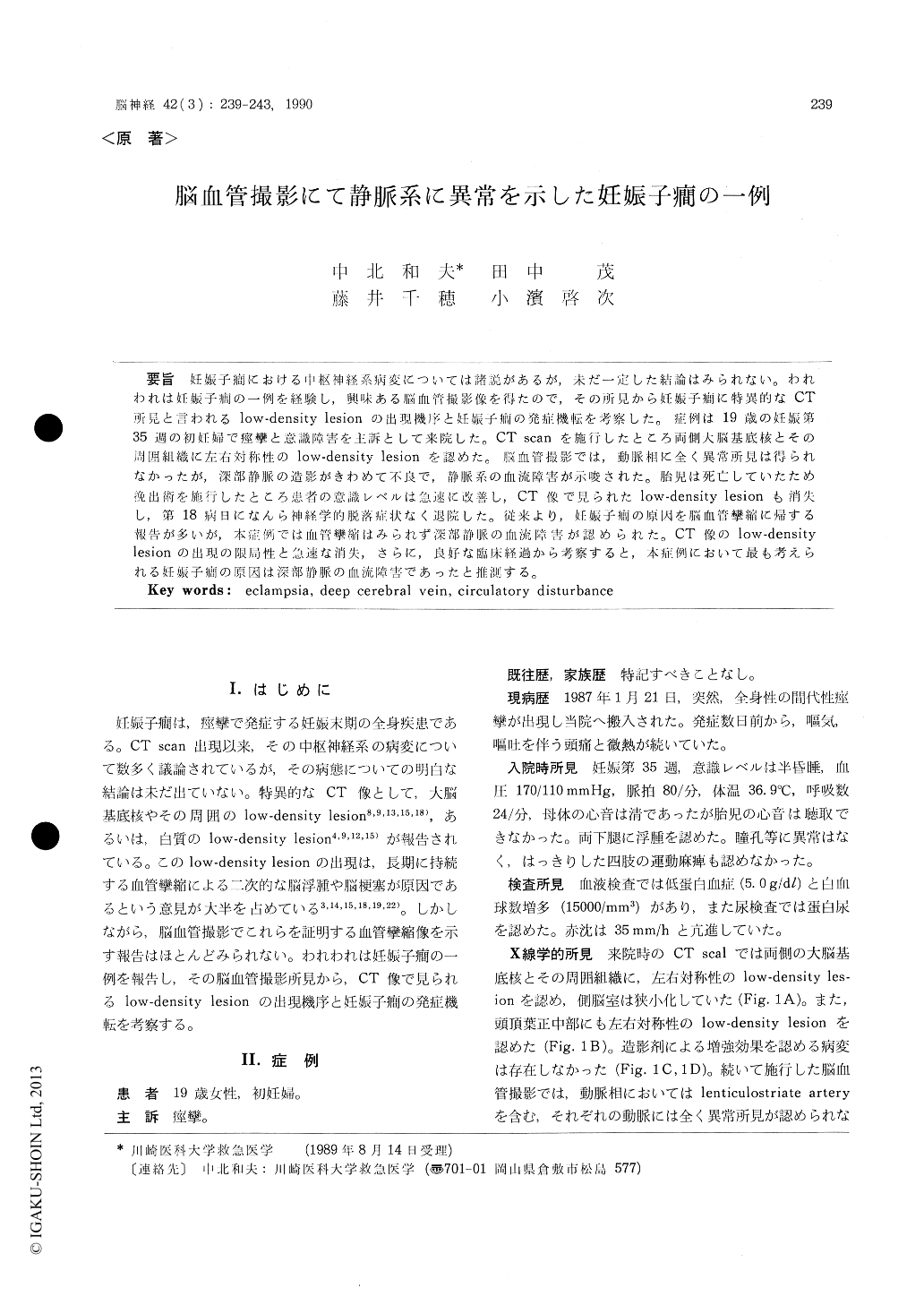Japanese
English
- 有料閲覧
- Abstract 文献概要
- 1ページ目 Look Inside
妊娠子癇における中枢神経系病変については諸説があるが,未だ一定した結論はみられない。われわれは妊娠子癇の一例を経験し,興味ある脳血管撮影像を得たので,その所見から妊娠子癇に特異的なCT所見と言われる1ow-density lesionの出現機序と妊娠子癇の発症機転を考察した。症例は19歳の妊娠第35週の初妊婦で痙攣と意識障害を主訴として来院した。CT scanを施行したところ両側大脳基底核とその周囲組織に左右対称性のlow-density lesionを認めた。脳血管撮影では,動脈相に全く異常所見は得られなかったが,深部静脈の造影がきわめて不良で,静脈系の血流障害が示唆された。胎児は死亡していたため挽出術を施行したところ患者の意識レベルは急速に改善し,CT像で見られたlow-density lesionも消失し,第18病日になんら神経学的脱落症状なく退院した。従来より,妊娠子癇の原因を脳血管攣縮に帰する報告が多いが,本症例では血管攣縮はみられず深部静脈の血流障害が認められた。CT像のlow-densitylesionの出現の限局性と急速な消失,さらに,良好な臨床経過から考察すると,本症例において最も考えられる妊娠子癇の原因は深部静脈の血流障害であったと推測する。
A case of eclampsia with interesting angiogra-phic findings is reported. A 19-year-old woman in the 35th week of gestation by date was admitted due to a sudden onset of generalized clonic con-vulsion and disturbance of consciousness. The diagnosis was eclampsia. On the second hospital day, extraction of a stillborn female was perfored by lamineria. Thereafter, the consciousness im-proved rapidly and she became alert on the follow-ing day. She was discharged without neurological deficit on the 18th hospital day. A CT scan on the day of admission showed narrow lateral ventri-cles and symmetrical low-density lesions in and around the basal ganglia. These had almost dis-appeared by the 10th hospital day. Carotid angio-graphy on admission revealed no abnormality in the arterial phase including the lenticurostriate arteries, but, early appearance of deep cerebral veins and some cortical veins was noted. These deep veins, however, were not distinct even in the venous phase. These angiographic findings suggested medullary dilatation caused by circula-tory disturbance of the deep cerebral veins. Most authors have stressed the contribution of diffuse arterial vasospasm in the pathogenesis of eclam-psia in relation to low-density lesions on CT scans. In the present case, we could not find vasospasm but found circulatory disturbance of the deep cerebral veins. These angiographic findings suggested that the appearance of the low-density lesions on the CT scan was most likely due to venous congestion caused by circulatory disturbance of the deep cerebral veins, since most of the deep medullary veins in the low-density lesions flowed into the deep cerebral veins. Moreover, the rapid recovery in CT findings and the clinical course supports our theory of venous congestion. Because most eclam-ptic patients with low-density lesions on a CT scan show rapid and full recovery, and CT abnor-malities disappear in a week or two, we suggest that circulatory disturbance of deep cerebral veins can also be a potent candidate in the pathogenesis of eclamptic lesions within the central nervous system.

Copyright © 1990, Igaku-Shoin Ltd. All rights reserved.


